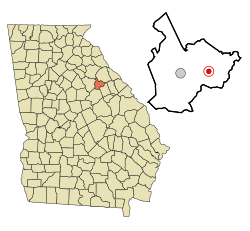Sharon, Georgia | |
|---|---|
 Location in Taliaferro County and the state of Georgia | |
| Coordinates: 33°33′31″N82°47′38″W / 33.55861°N 82.79389°W | |
| Country | United States |
| State | Georgia |
| County | Taliaferro |
| Incorporated (city) | 1884 |
| Government | |
| • Type | Mayor-council government |
| • Mayor | Renée Brown [1] |
| • Sharon City Council | Members |
| • City Clerk | Jane Kuehn |
| Area | |
• Total | 0.78 sq mi (2.03 km2) |
| • Land | 0.78 sq mi (2.02 km2) |
| • Water | 0.00 sq mi (0.01 km2) |
| Elevation | 600 ft (183 m) |
| Population (2020) | |
• Total | 104 |
| • Density | 133.33/sq mi (51.46/km2) |
| Time zone | UTC-5 (Eastern (EST)) |
| • Summer (DST) | UTC-4 (EDT) |
| ZIP code | 30664 |
| Area code | 706 |
| FIPS code | 13-69896 [3] |
| GNIS feature ID | 0322779 [4] |
Sharon is a city in Taliaferro County, Georgia, United States. The population was 104 in 2020.
